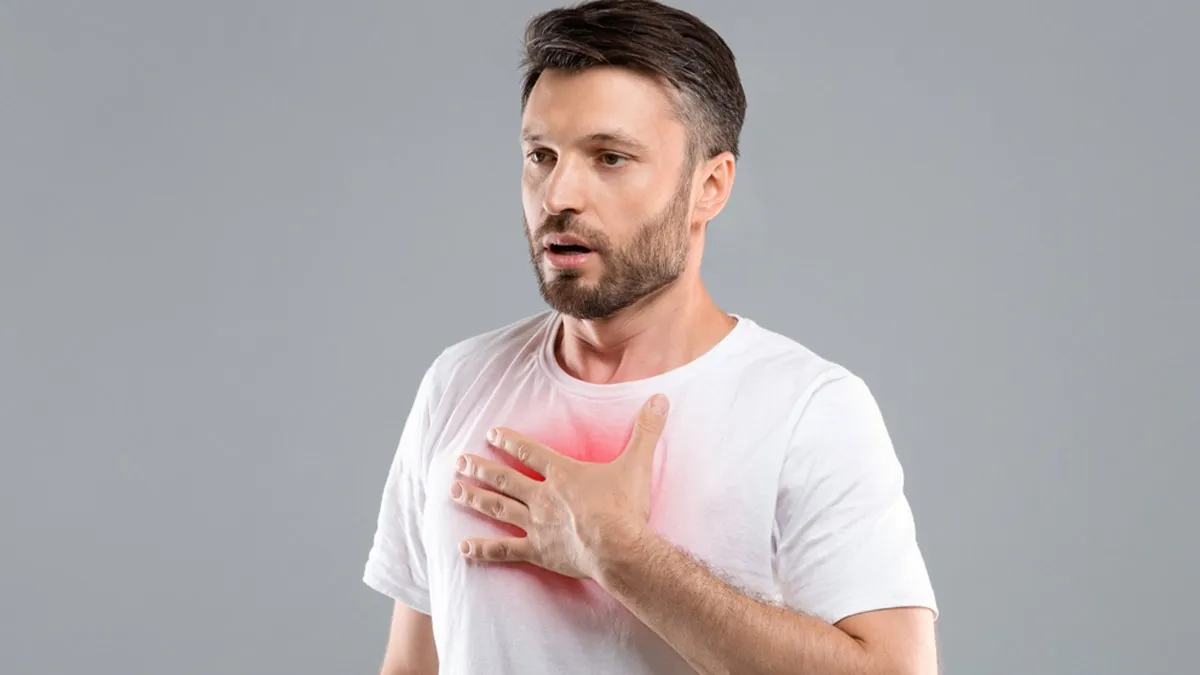
Chest pain is a common symptom that many people experience at some point in their lives. While it’s often linked to heart-related issues such as angina or heart attacks, sharp chest pain can sometimes be a warning sign of a far more serious and life-threatening condition—an aneurysm.
Table of Content:-
To understand more about this condition, OnlyMyHealth team interacted with Dr Sanjeev Dua, Principal Director, Neurosurgery, Max Super Speciality Hospital, Patparganj.
He explained, “An aneurysm occurs when a blood vessel weakens and bulges, and if it ruptures, it can lead to severe internal bleeding and even death. Understanding the signs of an aneurysm is crucial, as early detection can save lives.”
What is an Aneurysm?
According to a study by StatPearls, an aneurysm is a localised enlargement of a blood vessel caused by a weakness in the vessel wall. Dr Dua said, “It can develop in different parts of the body, including the brain, abdomen, and chest. One of the most dangerous types is a thoracic aortic aneurysm, which forms in the aorta, the large artery that carries blood from the heart to the rest of the body.”
A thoracic aortic aneurysm can be particularly dangerous because it often develops gradually and without symptoms. Over time, it may enlarge, exerting increasing pressure on surrounding organs. If it ruptures, it can cause massive internal bleeding, which is frequently fatal if not treated immediately.
Causes and Risk Factors

Several factors contribute to the formation of an aneurysm, including genetic predisposition, high blood pressure, and artery hardening. Common risk factors as per Dr Dua include:
- High blood pressure: Chronic hypertension weakens blood vessel walls, increasing the likelihood of aneurysm formation.
- Atherosclerosis: The buildup of fatty deposits in arteries makes them stiff and prone to aneurysms.
- Genetic conditions: Inherited disorders like Marfan syndrome or Ehlers-Danlos syndrome can lead to weakened blood vessels.
- Age: Aneurysms are more common in people over 60 years of age.
- Smoking: This accelerates the deterioration of blood vessel walls.
- Family history: If a close relative has had an aneurysm, the risk of developing one is significantly higher.
Also read: What Is Aortic Aneurysm? A Silent Cardiovascular Threat Often Mistaken For A Heart Attack
Symptoms of a Thoracic Aortic Aneurysm
While some aneurysms grow silently, a thoracic aortic aneurysm can cause distinct symptoms, which should never be ignored. Dr Sanjeev Dua explains, “Sharp chest pain, particularly if it radiates to the back or abdomen, could be an indicator of an aortic aneurysm rather than a heart attack. The pain is often sudden and severe, requiring immediate medical attention.”
Other symptoms may include:

- Severe chest pain – Usually sharp, stabbing, or tearing in nature, and may spread to the back or abdomen.
- Difficulty breathing – The aneurysm can press against the lungs or airways, leading to shortness of breath.
- Hoarseness or difficulty swallowing – If the aneurysm compresses structures in the neck or throat, it can cause vocal changes or trouble swallowing.
- Dizziness or fainting – If blood flow is compromised, it can lead to light-headedness or loss of consciousness.
A ruptured thoracic aortic aneurysm is a medical emergency. If you experience sudden, intense chest pain, dizziness, or breathing difficulties, seek immediate medical attention.
Diagnosis and Treatment
To diagnose an aneurysm, doctors use imaging tests such as:
- Ultrasound
- CT Scan
- MRI
“These tests provide a detailed view of the aorta, helping detect abnormalities. In some cases, an aneurysm may be discovered during a routine screening, especially in individuals with a family history or known risk factors,” Dr Dua said.
The treatment depends on the size, location, and rate of growth of the aneurysm.

- Small, stable aneurysms: Doctors may recommend regular monitoring rather than immediate intervention.
- Large or growing aneurysms: Surgery is often required. This may involve open repair (replacing the affected portion of the aorta) or a minimally invasive endovascular stent grafting procedure.
- Emergency surgery: If an aneurysm is at risk of rupturing or has already burst, immediate surgical intervention is essential to prevent fatal complications.
Also read: Is Your Bathroom a Hidden Risk Factor for Heart Attacks? Here's What You Need to Know
Prevention and Management
Although aneurysms cannot always be prevented, lifestyle modifications can significantly reduce the risk.
- Control blood pressure – Maintain a healthy blood pressure level through diet, exercise, and medication if needed.
- Quit smoking – Smoking weakens blood vessels, increasing the risk of aneurysm formation and rupture.
- Adopt a heart-healthy lifestyle – Regular exercise, a balanced diet, and avoiding excessive alcohol intake can help keep arteries strong.
- Genetic screening – If aneurysms run in your family, discuss regular screening with your doctor.
Conclusion
Sharp chest pain should never be ignored. While it can be caused by heart conditions, it could also be a sign of a life-threatening aneurysm. Dr Sanjeev Dua advises, “If you experience sudden, severe chest pain, dizziness, or breathing difficulty, it is essential to seek medical attention immediately. Early diagnosis and treatment can make all the difference.”
By understanding the warning signs, managing risk factors, and undergoing regular screenings, individuals can take proactive steps to prevent aneurysm-related complications. If in doubt, always err on the side of caution and seek urgent medical care.
Also watch this video
How we keep this article up to date:
We work with experts and keep a close eye on the latest in health and wellness. Whenever there is a new research or helpful information, we update our articles with accurate and useful advice.
Current Version